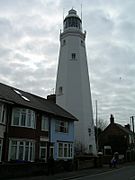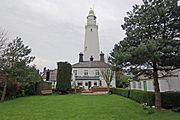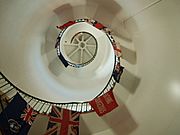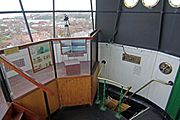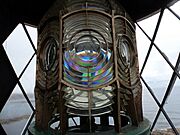Withernsea Lighthouse facts for kids
| Location | Withernsea East Riding of Yorkshire England |
|---|---|
| Coordinates | 53°43′51″N 0°01′44″E / 53.730953°N 0.028751°E |
| Year first constructed | 1894 |
| Deactivated | 1976 |
| Construction | brick tower |
| Tower shape | tapered octagonal prism with balcony and lantern |
| Markings / pattern | white tower and lantern |
| Height | 128 feet (39 m) |
The Withernsea Lighthouse is a famous landmark located right in the middle of the town of Withernsea, in the East Riding of Yorkshire, England. Even though it's called a lighthouse, it's actually quite far from the sea! This tall, white tower stands about 39 meters (127 feet) high. It took about 18 months to build, from 1892 to 1894. The lighthouse used to be run by a group called Trinity House, which manages lighthouses in England. However, it stopped working as a lighthouse on July 1, 1976. Today, it's a popular museum where visitors can learn about its history and enjoy amazing views.
Contents
History of the Lighthouse
Why it was Built Inland
When the Withernsea Lighthouse was built, it was placed about 400 meters (a quarter of a mile) away from the coastline. At that time, there were only sand dunes between the lighthouse and the sea. People were worried about the land being washed away by the ocean, a process called coastal erosion. So, they decided to build the lighthouse further back to keep it safe.
The Original Light
The very top part of the lighthouse, called the lantern, and the special glass lens inside it, were not new. They came from an older lighthouse at High Whitby that had recently closed down.
At first, the light came from an oil lamp with eight wicks. This lamp was placed inside a large, fixed lens called a Fresnel lens. A Fresnel lens is a special type of lens that helps to focus light into a strong beam, making it visible from far away. This particular lens was made in 1858. The light would flash three times quickly every minute. This was done by a clockwork machine that would briefly block the light, making it "occult" or disappear. Later, in the early 1900s, a different type of oil lamp was used, but the triple-flashing pattern stayed until 1936.
Electrifying the Light
In 1936, the lighthouse got a big upgrade: it became electric! A powerful 1500-watt light bulb was installed. It used a new, spinning lens that flashed a white light every three seconds. This light could be seen from about 31 kilometers (17 nautical miles) away. Withernsea was the first lighthouse in the North of England to switch from oil to electricity.
The lighthouse ran on regular electricity from the town. But if the main light ever failed, an automatic system would switch on a battery-powered emergency lamp. This was a very new and important safety feature at the time, and it was later used in many other lighthouses.
The large lens inside the lighthouse was very heavy, weighing two tons! It floated in a pool of mercury, which helped it turn smoothly. A clockwork mechanism kept it spinning. This lighting system, lens, and clockwork continued to be used until the lighthouse closed in the 1970s. Before it was decommissioned in 1976, the lighthouse was looked after by a couple who lived in a small house next to it.
Withernsea Lighthouse Today
What to See at the Museum
Today, the Withernsea Lighthouse is a museum that's fun to explore. At the bottom of the lighthouse, you can find exhibits about the RNLI (Royal National Lifeboat Institution) and HM Coastguard. These displays show models and old photos, telling the stories of shipwrecks in the area. You can also learn about the brave Withernsea lifeboat crews who saved 87 lives between 1862 and 1913. There are also exhibits about the lifeboats from nearby Spurn.
There's a room dedicated to local history with old photos from the Victorian and Edwardian times. These pictures show what the town, its pier, and railway used to look like. You can also find a special memorial to Kay Kendall, a famous film star from the 1950s who was born in Withernsea.
Views from the Top
If you're feeling energetic, you can climb the 144 steps to the lamp room at the top of the lighthouse! From there, you get amazing views of Withernsea and the surrounding area. You won't see a lamp there anymore, though. The original lamp was moved to St Mary's Lighthouse in Tyne and Wear, where it can still be seen today.
The lighthouse and the houses where the lighthouse keepers used to live are special buildings. They are listed as Grade II listed buildings, which means they are important historical structures that are protected.
Modern Use
Even though it's a museum, the lighthouse still has a modern purpose. There are antennae attached to it that help provide mobile phone coverage for the local area.
Tolkien's Two Towers Theory
- Further information: The Two Towers
Did you know that the famous author J. R. R. Tolkien, who wrote The Hobbit and The Lord of the Rings, might have been inspired by the Withernsea Lighthouse? During the First World War, Tolkien was stationed near Withernsea, at a place called Thirtle Bridge. It's known that he found ideas for his stories and languages while he was in this area.
One well-known story is how he was inspired by his wife, Edith, singing and dancing in the woods. This gave him the idea for the Elven princess Lúthien Tinúviel in his books. Many articles have been written about how East Yorkshire influenced Tolkien's fantasy worlds.
From Thirtle Bridge, the Withernsea Lighthouse stands tall on the horizon, less than 3.2 kilometers (2 miles) away. There's also another tall structure nearby called the Black Mill at Waxholme. It's not as tall as the lighthouse but is located on high ground between Thirtle Bridge and Withernsea.
Some people, like Michael Flowers from the Tolkien Society and local author Phil Mathison, believe these two "towers" – the white lighthouse and the dark mill – might have inspired Tolkien's idea for the "Two Towers" in his famous book, The Two Towers. They point out that in Tolkien's own drawings for the book's cover, the White Tower often looks a lot like a lighthouse. The colors and even the window patterns in his drawings seem to match the lighthouse and the mill.
While there are other ideas about what inspired the Two Towers, the Withernsea Lighthouse and the Black Mill are unique because their distinct colors match the descriptions in Tolkien's book.
Gallery
-
The old Withernsea optic (now in St Mary's lighthouse, Whitley Bay)
See also
- List of lighthouses in England


